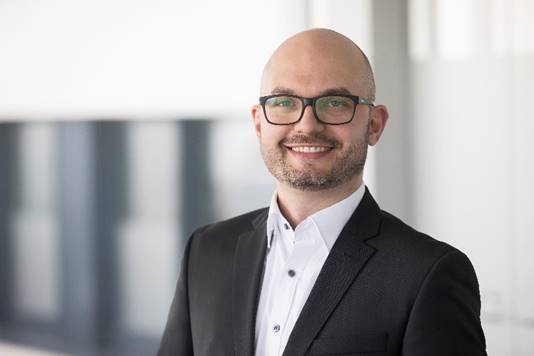
Throughout the world, the corona pandemic has generated a completely new awareness of the need for improved hygiene, a subject that has become a driving force for innovation in many sectors. In the run-up to Texcare International, Dr. Timo Hammer discusses the significance of the subject for the professional textile-care sector, in a Texcare International news release. Texcare International will be held in Frankfurt am Main from 27 November to 1 December 2021.
Dr. Hammer is Managing Director of both the Hohenstein Laboratories and the German Certification Association for Professional Textile Services, which awards the RAL 992 seal of quality.
Q: In your daily work, you check textile-care companies with regard to hygiene. What has changed since the outbreak of the corona pandemic?
Dr. Timo Hammer: “At the beginning of the pandemic, many laundries approached us and asked an incredible number of practical questions. For example, how can I protect my employees if we receive washing that is contaminated with corona? Or how can I organize it so that my driver can deliver the laundry despite the curfew? In the past, hygiene was ‘nice to have.’ Today, it is also the prerequisite for companies to protect their employees. Hygiene is a concept and employees must understand the basic principles of hygiene. And we continuously support our members with training courses. Which means they are then able to competently answer questions from their customers, i.e., hospitals and care facilities.”
Q: The pandemic has put the spotlight on the subject of textile hygiene. What are the chances of growth for the worldwide sector?
Dr. Timo Hammer: “Enormous. And things are really getting going now. This is the result of the huge leap in awareness for hygiene. People all over the world are focusing on this very subject now. In tourist regions, for example, guests are asking about the hygiene management of their hotels and how the laundry is being washed. To this end, hotels are demanding a hygiene certificate from their laundries.”
Textile hygiene is an essential aspect of health care. In your opinion, what are the advantages of reusable textiles over disposable articles?
Dr. Timo Hammer: “At first glance, disposable products are frequently cheaper. However, if you compare the costs across the whole time they are to be used – the ‘total cost of ownership’ – reusable articles come out top. The barrier function and degree of protection offered by reusable surgical gowns are also significantly better than those of disposable products. A study about this was published by MCQuerry et al. in the American Journal of Infection Control in 2020.
In addition to the lower overall cost, multiple-use articles are also more sustainable. Many healthcare companies are now certified and textiles play an important role in this. Moreover, reusable garments are more comfortable to wear and can be modified to take account of customers’ requirements in terms of fit and size.
Q: How do you see the trend to reusable articles developing in the future?
Dr. Timo Hammer: “If the trend to reusable articles is to continue, laundries must have a quality management system that ensures no loss in value when such articles are disinfected. Detergent manufacturers are aware of this and thus develop products that contribute to both hygiene and longevity.”
Q: What role does digitalization play in ensuring unbroken hygiene management from the laundry to the customer? What potential do you see for the future in this connection?
Dr. Timo Hammer: “Yes, this is actually an important point and there is a lot going on at present. In laundries, digitalization over recent years has primarily been aimed at tracing articles with the aid of RFID chips. In this case, it makes sense to link this process with hygiene-management data and thus digitalize the transparency of the hygiene chain. I anticipate numerous innovations in the field of all-embracing digital hygiene management. On the micro-biological side, however, contact tests and contaminated sample washing are still necessary to demonstrate sterility. Data from control points developed in accordance with the HACCP concept, where the microbiological tests are carried out, can be integrated into an overall digital concept. This increases reaction speed and the customer can be provided with information in real-time.”
Q: Has the pandemic become a driving force for innovation in the hygiene sector? In which segments have there been especially outstanding innovations?
Dr. Timo Hammer: “There have been many good new products in the field of antiviral textiles recently. Now, innovations are shooting up where there used to be a niche. Generally, the effect is long-lasting when antiviral substances, such as copper, are integrated into fibers. However, it is important to ensure that the coating is suitable for the intended application. For example, if the antiviral effect only works when the textile is damp, that textile should not be used in primarily dry settings. Today, hygiene is extremely important in all spheres of life. Accordingly, hygiene monitoring is one of the driving forces of innovation and simple systems – such as the Hohenstein HyMo-Box, which can also be used by laypeople – have a major advantage.”
Q: What contribution can Texcare International make to increasing awareness of the subject of textile hygiene?
Dr. Timo Hammer: “It is good that emphasis is being given to the subject of hygiene during the run-up to Texcare International and, in lectures and forums, at the fair itself. The visitors to the fair are unlikely to include anyone with no interest in the subject of textile hygiene. When it comes to hygiene, many people immediately think of building cleaning services, hand hygiene and antibiotic management but not of textiles. It would be good if Texcare International could show the world just how important professional textile care is for fighting the pandemic and interrupting infection chains.”
Image: Dr. Timo Hammer, Managing Director, Hohenstein Laboratories
Credit: Hohenstein











